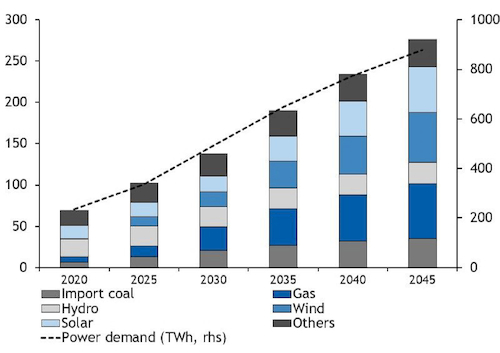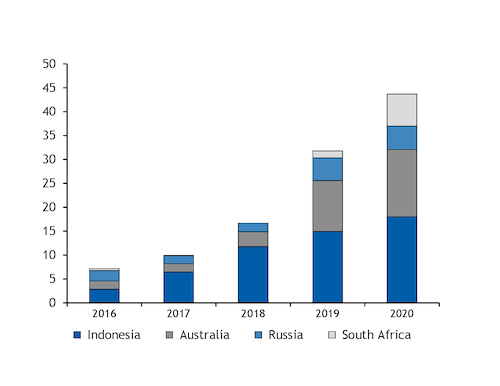The Vietnamese government has pared back its 2030 target for installed coal-fired capacity, although imported-coal-fired generation capacity is still expected to more than triple.
Vietnam is now targeting 37.3GW of installed coal capacity by 2030, according to the latest draft of the government’s long-term electricity development plan published in February, down from a previous target of 55.3GW.
Assuming a 60pc average capacity factor, Vietnam’s build-out of imported-coal-fired capacity could support up to 39.7mn t of NAR 5,800 kcal/kg-equivalent coal burn by 2030, according to Argus analysis.
In the government’s base scenario, imported-coal-fired capacity will increase by 14.2GW to 20.4GW over 2020-30, with capacity running on domestic supply rising more slowly by 2.7GW to 17GW.
There are six 600MW imported-coal-fired units schedule for completion by 2022, according to Vietnam’s draft electricity plan. A 3.6GW rise is equivalent to 7mn t of NAR 5,800 kcal/kg coal consumption annually, Argus calculates assuming a 60pc average load factor.
The remaining 13.3GW of prospective plants to run on imported and domestic coal are at earlier stages of development, with some projects still at the pre-construction stage.
Argus‘ consulting division forecasts annual Vietnamese thermal coal imports to increase by 1.2mn t on the year to 45mn t in 2021. Overall imports to southeast Asian countries are projected to increase from 2020 by 13.2mn t and 22mn t to 160.5mn t and 182.5mn t in 2021 and 2022, respectively.
Power demand to more than double
The ministry of industry and trade published a low, medium and high-generation forecast scenario for electricity output to 2030 in its latest long-term plan. National electricity production is expected to increase to 513.5TWh, 551.3TWh, or 595.4TWh, respectively, by 2030 in the three scenarios, from 227TWh in 2019.
This means Vietnam’s power output is expected to more than double even under a low-production scenario, which is in line with the International Monetary Fund’s annual real GDP growth projection of 6.5-7.2pc to 2025, published in its March 2021 Vietnam country report.
The government has laid out plans to nearly double the country’s installed generation capacity to 137.7GW by 2030 from 69.3GW in 2020 in its base scenario, to cope with the expected surge in power demand.
In that scenario, Vietnam’s increase in installed imported-coal-fired capacity to around 20.4GW would represent a 6 percentage point increase in coal’s share of total capacity to 15pc by 2030. But the share of capacity running on domestic coal will gradually decrease to 12pc from 21pc during the same period.
Vietnam’s installed gas capacity will increase the most on an outright basis according to the plan, quadrupling to 28.7GW by 2030 from 7.1GW in 2020. New capacity additions will raise gas’ share of the Vietnamese capacity mix to 21pc from 10pc, although coal’s combined share would still be higher in 2030 at 27pc.
Renewables to lead the growth in generation capacity
Renewables capacity is expected to grow strongly through to 2045, with onshore wind capacity projected to record the biggest growth rate.
Under the base scenario, Vietnam’s onshore wind and solar capacity is scheduled to increase to 16.01GW and 18.64GW by 2030, respectively, with the potential to further expand to 39.61GW and 55.09GW in 2045. By comparison, onshore wind and solar capacity stood at 600MW and 16.64GW, respectively, in 2020.
Vietnam added around 225MW of wind and 10.9GW of solar capacity last year alone, according to Argus calculations based on 2019 capacity data released by the International Renewable Energy Agency.
Solar’s share of Vietnam’s total generation capacity has already surpassed that of Germany and the country possesses the biggest wind and solar fleet in southeast Asia, according to Ha Dong Son, the director of the Center for Energy and Green Growth Research in Vietnam. The share of wind — onshore and offshore — and solar capacity in its generation mix stood at 25pc in 2020 and is scheduled to gradually increase to 27pc in 2030 and 42pc in 2045.


By Evelyn Lee
Source: argusmedia
